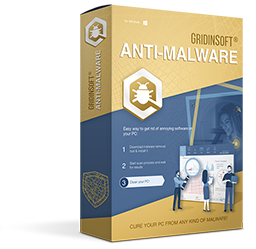Recently, Fimecas.com site surfaced, promoting itself as a place to store cryptocurrency and other assets safely. I managed to gather credible supporting information that clearly indicates it is, actually, a scam service.
Despite the promises of the most easy, dependable, and client-friendly service, Fimecas.com does not offer any of them. All this is just a gilded wrap around a blatant scam, which steals your money and data and never gives them back. Any stories about gifts, backing from celebrities etc are absent as well.
Fimecas Scam Overview
Originally, Fimecas poses as a cryptocurrency trading & cryptowallet service with exceptionally low commission fees. Another bright selling point for this service is partnerships with celebrities that are known as crypto activists. Warren Buffet, Elon Musk, Vitalii Buterin, Jeff Bezos – the site says about being supported by them. To make these claims look real, con actors employ AI-generated videos where those celebrities advertise the fraud as the best thing in the world. For obvious reasons, Elon Musk is the most common choise for that. But, as I said in the introduction, all this is just a blatant wrap around a transparent scam.
First and foremost, Fimecas repeats the design of numerous similar websites. There are quite a few examples, like Fenutix, Fenax or Fabledodds. They are completely indistinguishable in terms of graphic elements, with small discrepancies in the webpage header. Other details, and sometimes even crypto wallet addresses, are unchanged. Probably, all these scam sites are managed by a single team of frauds.
Cryptocurrency Scam Summary
| Website | Fimecas.com |
| Hosting | AS13335 Cloudflare, Inc. United States, San Francisco |
| IP Address | 104.21.38.142 |
| Threat Type | Scam/Fraud |
| Scam Type | Fraudulent offers of cryptocurrency services |
How the Fimecas Scam Works?
Fimecas is a part of a large cryptocurrency scam scheme that started circulating vividly in 2023. Swindlers who stand behind it use numerous website designs, which still share the same overall layout. Another common element are the ways the scams like NAME are promoted, and the manner all this ends up to the victim of the scam. To reach peak efficiency, frauds apply complex psychological tricks that make the user believe in the validity of the website. But let’s review them one by one.
Step 1: Promotion
To begin the deceptive scheme, criminals create and fill accounts on popular social media platforms. They primarily target Facebook, Instagram, Twitter, and TikTok. Subsequently, the promotional campaign starts. Utilizing bots and sponsored ads (when possible), scam actors boost the exposure of their fraudulent activities to potential victims. And as I said, scammers do not shy away using generative AI for creating videos with the aforementioned celebs that promote their scam to the public. To boost the folks even more, swindlers claim the bonus for every user who joins the service immediately.

Promotions of cryptoscams like Fimecas in TikTok. Most of these videos are AI-generated deepfakes
Users get an incentive to register, attracted by the promise of obtaining crypto rewards valued at hundreds of dollars, all free of charge. To augment the attractiveness of the offer, false suggestions of cooperation with a celebrity are added. As you may guess, these claims are completely baseless.
Step 2: Gaining Traffic
After following the promos, targets end up on a page filled with appealing offers. “Crypto starts with Fimecas”, “Your crypto savings are secured with Fimecas, “Start earning with Fimecas – they look rather reliable. To heat up the interest and make the users proceed to step 3, scammers say that unlocking the promised bonus requires registration. And as nothing questionable happens at this point, unaware users happily keep on – especially since the bonus appears to be right behind the corner.
This is the last stage when it is possible to steer away from the scam without any losses. Before you register using your personal information, crooks will not earn even a nickel from your presence on the website.
Step 3: Data Gathering
This is the starting poing of the main fraud action. As I just mentioned, frauds bait folks into registration to get bonuses. And all the personal information needed for it – username, email, cryptocurrency wallet address – is valuable for user identification. Exclusively by gathering this information and selling it further into the Darknet, swindlers can earn quite a penny. Nonetheless, their plans go much further.
As it turns out, you cannot use the promised bonus right away. To make it at least usable for crypto purchases, you need to top up the account with the equivalent sum. And this is what initiates the final stage of the scam.
Step 4: Requesting funds
Obviously, any cryptocurrency operations require having capital on your account. In the case of Fimecas, users are also compelled to top up to claim the bonuses. And these top ups is what creates most of the cash flow to this scam website. By topping up the account, users hope to get the pledged gift (usually $500-1000 in USDT), and may start participating on this site hoping to use all the credited funds and withdraw them.
This is where the victim notices the problems. When keeping an eye on the real crypto wallet vs what the website says, you can observe that no transactions are done whatsoever. And then, when you’d try to retrieve the capital from your account, the scam is finally uncovered to the user.
Step 5: Escaping from Funds Withdrawal
Needless to say that fraudsters have zero intentions to return your money. But to make the denial look more legitimate, they’ve developed a whole bunch of reasons to decline the transfer-out request. Most of them repeat what Know Your Client requirements say, but in this case they are here exclusively to make the wireout impossible.
By asking for your personal info, deceivers just stall hoping for you to accept the loss and stop contacting them. If you don’t – well, there are multiple other checks you would desperately need to undergo before getting your funds back. And each of these checks will reveal more and more info of yours, which – you guessed it right – will be then traded on the Darknet. Never reveal your real info to strangers!
Signs of Scam
I gathered several facts that point at the scammy nature of the Fimecas.com. Actually, there are a lot of scams that fall under the same points, so they are pretty much universal.
- Absent company details. Fimecas does not provide any documentation about its ownership, location or registration. No legitimate contact details are given either. Moreover, it appears that the domain and all social network pages were registered quite recently.
- Fake sponsorship from a celebrity. Scams like Fimecas like to pick a celebrity as a sponsor of this entire campaign. For obvious reasons, fraudsters generally choose Elon Musk, Jeff Bezos, Mr. Beast, Mark Zuckerberg, and similar celebrities. They do not disdain claiming partnership with a company as well. Even though Coinbase, Binance or MetaMask never heard of Fimecas, they do not care – this creates a halo of credibility.
- Potential Ponzi Scheme. The scam relies on a Ponzi-like referral system to spread reach through social media. In fact, only the first members will receive the payoff, at the cost of the money brought by other members.
- Hype without facts. Frauds can cheer up their victims from time to time, using claims about non-existent events. “We got contracts with Coinbase”, “Elon Musk mentioned us as the most prolific crypto project” – you could likely hear something like that. This is made to make people believe in their money return. This can be the sauce to make people top-up their accounts once again.
- Crypto-only incoming payments. Whether the user tries to top-up the account, hackers will only accept payments in crypto – no bank transfers or other payment methods. Such an approach completely hides the identity of the company and deprives you of the ability to ask for a refund.
- Claims are too good to be true. Let’s be sane and sober: even in crypto space, there are not many places where you can earn 50-100-200%. Being able to participate in all of them is nearly impossible, as well as it is impossible to insure or hedge all the risks. Even by that reason alone I can tell that the Fimecas is a definite scam.
What Should I do as a Victim?
If you had to deal with Fimecas site and fell victim to that scam, there are still some steps to take. They will make further scam attempts harder, and also boost the knowledge about that scam among folks.
- Immediate Reporting. Your initial step should involve promptly notifying local authorities specializing in financial fraud. Extend your reach by reaching out to wallet providers and engaging with social networks’ technical support teams. These actions serve to raise the bar for the scammers’ operations.
- Share among Friends. Amplify your efforts by informing your close friends about the scam. Similar to informing authorities, this dissemination of information restricts the scammers’ potential victim pool.
- Preserve Crucial Information. Compile a comprehensive evidence archive by capturing screenshots and archiving all relevant website-related data. Collect the website URL, screenshots of the main page, login interface, end-user license agreement (EULA), account top-up menu, and wallet addresses. These records could provide vital clues for authorities in their pursuit of the scammers.
- Exploring Refund Options. While most banks’ refund policies may exclude cryptocurrency payments, it’s advisable to explore potential refund avenues under specific circumstances. Maintain hope until you obtain confirmation of the loss.
- Transform Loss into Knowledge. Turn your financial setback into an opportunity for growth. View your loss as an investment in understanding the strategies employed by crypto scam sites. Familiarize yourself with their telltale characteristics, the methods they employ to entice individuals, and the extravagant promises they make. Equipped with this insight, you’ll be well-prepared to spot and evade future traps without suffering additional financial setbacks.
Scan your system for possible malware infections
Beware of cross scams! Scam actors can use your trust to make you download some stuff or interact with certain documents. It may be a trap that installs malware to your system. There are no moral barriers or limits for these scoundrels.
Throughout the course of the scam, rascals may reach out to you with particular documents. Alternatively, they may suggest you to set up “cryptocurrency wallet applications” or “browser extensions” to streamline access to your cryptocurrency funds. As we earlier determined, these scammers have no plan of returning your funds. So, what do these emails and browser extensions represent? You guessed – this is another element of the scam designed to entice you into willingly running malicious programs onto your computer.
Both plugins and files added to emails can serve as a carrier for diverse malicious software. In this situation, I foresee the presence of spyware and stealers among all types of threats. While it is not mandatory for scammers to distribute malware, the probability is always significant. As noted, their morality is of little concern, and their dignity is already neck deep in mud. They have no scruples to lose and intend to boost gains.
Remove spyware with Gridinsoft Anti-Malware
We have also been using this software on our systems ever since, and it has always been successful in detecting viruses. It has blocked the most common malicious programs as shown from our tests with the software, and we assure you that it can remove spyware as well as other malware hiding on your computer.

To use Gridinsoft for remove malicious threats, follow the steps below:
1. Begin by downloading Gridinsoft Anti-Malware, accessible via the blue button below or directly from the official website gridinsoft.com.
2.Once the Gridinsoft setup file (setup-gridinsoft-fix.exe) is downloaded, execute it by clicking on the file.
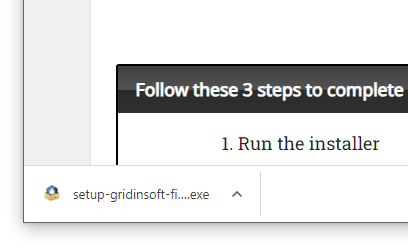
3.Follow the installation setup wizard's instructions diligently.
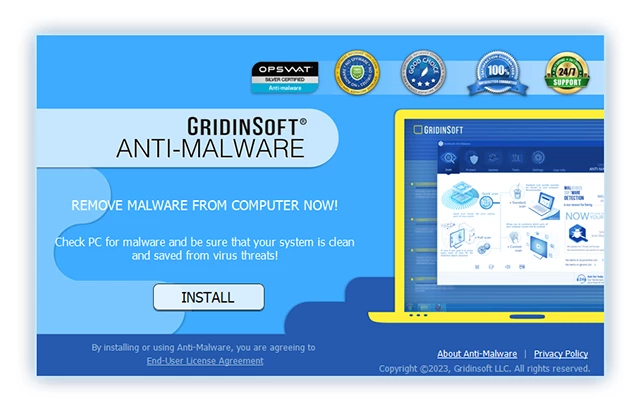
4. Access the "Scan Tab" on the application's start screen and launch a comprehensive "Full Scan" to examine your entire computer. This inclusive scan encompasses the memory, startup items, the registry, services, drivers, and all files, ensuring that it detects malware hidden in all possible locations.
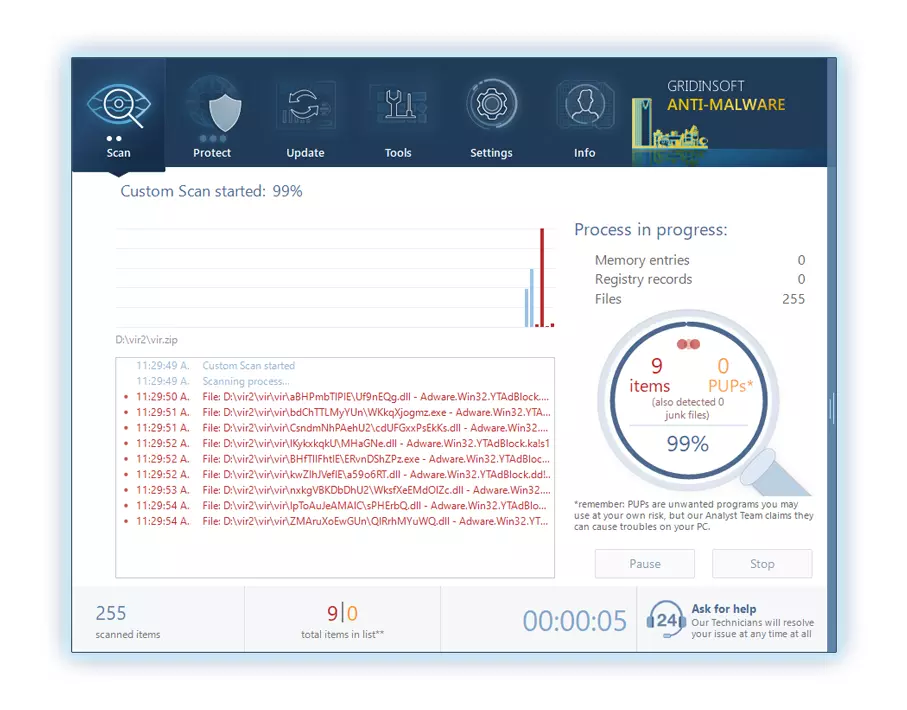
Be patient, as the scan duration depends on the number of files and your computer's hardware capabilities. Use this time to relax or attend to other tasks.
5. Upon completion, Anti-Malware will present a detailed report containing all the detected malicious items and threats on your PC.
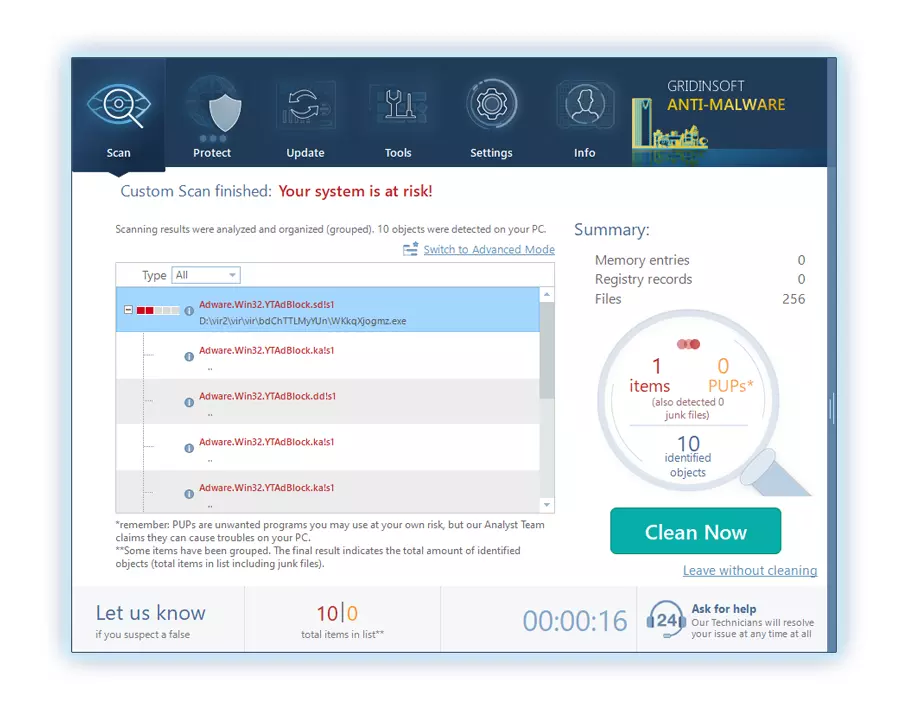
6. Select all the identified items from the report and confidently click the "Clean Now" button. This action will safely remove the malicious files from your computer, transferring them to the secure quarantine zone of the anti-malware program to prevent any further harmful actions.
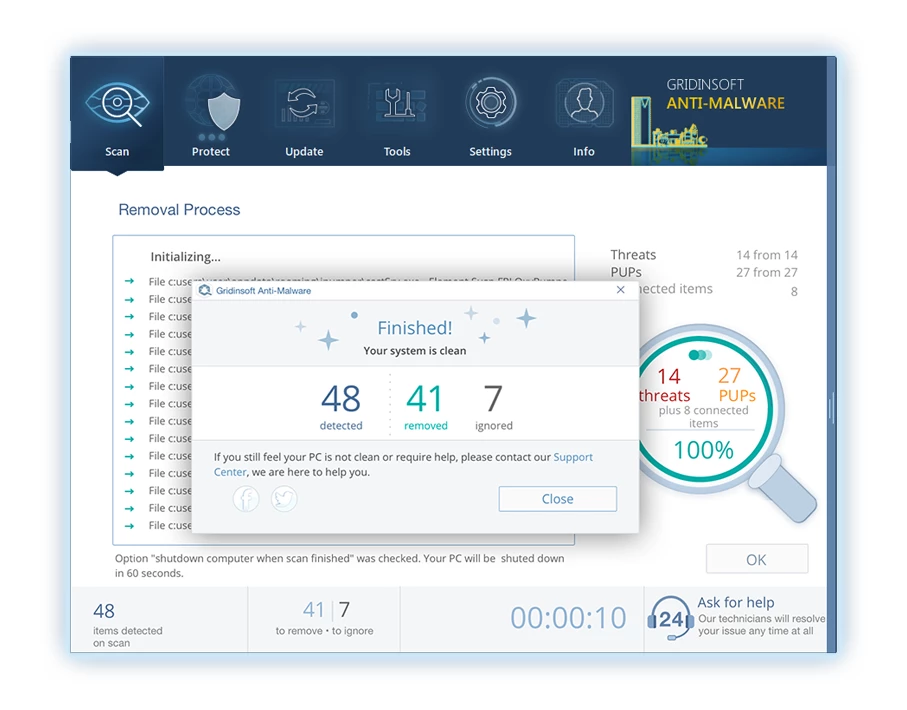
8. If prompted, restart your computer to finalize the full system scan procedure. This step is crucial to ensure thorough removal of any remaining threats. After the restart, Gridinsoft Anti-Malware will open and display a message confirming the completion of the scan.
Remember Gridinsoft offers a 6-day free trial. This means you can take advantage of the trial period at no cost to experience the full benefits of the software and prevent any future malware infections on your system. Embrace this opportunity to fortify your computer's security without any financial commitment.
Frequently asked questions
The vast majority of information posted on the Fimecas site is false. It is either fabricated, or a manipulation that misses the context of mentioned events. However, things like quotes or other interactive elements related to current prices may be trustworthy. But I would rather avoid using them as a primary source of information.
No, there is no legitimate information on the Fimecas site. The operators of this site use fabricated details and deceptive tactics to create an appearance of credibility, such as appealing visuals and claims of being a licensed company. However, these claims are false, and the site is part of a larger network of interconnected crypto scam sites designed to defraud victims. The scammers manipulate users into providing sensitive personal information and making deposits, ultimately leading to the loss of funds.
Unfortunately, recovering funds lost to a scam like Fimecas can be extremely challenging, if not impossible. Scammers often operate from obscure locations and use various tactics to cover their tracks, making it difficult to trace or retrieve the stolen funds. In many cases, these scams are designed to exploit victims and disappear once they have obtained the money.
Spotting crypto trading scams requires vigilance and a critical eye. Here are some tips to help you identify potential crypto trading scams in the future:
- Scrutinize Celebrity Endorsements. Be cautious of endorsements from celebrities or public figures. Scammers often fabricate endorsements to gain credibility.
- Resist Urgency. Watch out for tactics that create a sense of urgency to pressure quick decisions. Legitimate investments offer time for research and consideration.
- Consult Reviews and Feedback. Look for independent reviews and feedback from fellow traders. Scammers may create fake positive reviews, but negative reviews can provide valuable insights.
- Question Unrealistic Promises. Be skeptical of offers promising unrealistically high returns or guaranteed profits. If an investment opportunity seems too good to be true, it likely is.
- Verify Regulation and Licensing. Check if the platform or service is regulated and licensed by relevant authorities. Scammers often operate without proper authorization.
If you have become a victim of a Fimecas or similar crypto trading scam, it’s important to take immediate action to minimize further damage and increase the chances of recovering your losses. Here’s what you should do:
- Notify Cryptocurrency Exchanges. Should you have employed a cryptocurrency exchange for transactions linked to the scam, inform the exchange about the fraudulent activity. In certain cases, they could extend their assistance.
- Contact Financial Institutions. If you conducted any payments or deposits through your credit card or bank account, promptly notify your financial institution. They might offer assistance in contesting transactions or initiating chargebacks.
- Thoroughly Document. Gather and safeguard all pertinent information, including emails, screenshots, transaction records, and any correspondence with the scammers. This documentation holds utmost importance for reporting the scam and seeking assistance.
- Immediately Halt Communication. Once you recognize that you have fallen victim to a scam, cease all communication with the scammers. Refrain from responding to their emails, messages, or phone calls.
- Seek Legal Advice. Consult with a legal professional who specializes in fraud or financial matters. They can provide advice on potential legal actions you can take to recover your funds.
- Consult Legal Counsel. Seek counsel from a legal expert specialized in fraud or financial matters. They can provide guidance on potential legal avenues for recovering your funds.
- Inform the Authorities. Lodge an official report with your local law enforcement agency and relevant regulatory bodies within your country. Present them with the amassed evidence. This step instigates investigations and enhances awareness about the scam.

